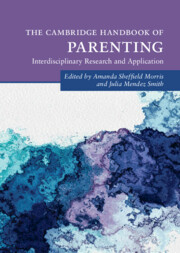Book contents
- The Cambridge Handbook of Parenting
- Cambridge Handbooks in Psychology
- The Cambridge Handbook of Parenting
- Copyright page
- Dedication
- Contents
- Contributors
- Figures
- Tables
- Introduction
- Part I Foundations of Parenting
- 1 Foundational Theories and the Establishment of Parenting Science Research
- 2 Parenting, Challenges, Brain Development, and Attachment Strategies
- 3 Parenting and Brain Development
- 4 Parenting and Children’s Social and Emotional Development: Emotion Socialization across Childhood and Adolescence
- 5 Parents Matter: The Cornerstone for Children’s Cognitive and Language Development
- 6 Discipline and Punishment in Child Development
- 7 Parenting From a Cultural and Global Perspective: A Review of Theoretical Models and Parenting Research in Diverse Cultural Contexts
- Part II Parenting across Development: Social, Emotional, and Cognitive Influences
- Part III Parental Factors That Impact Parenting
- Part IV Child Factors that Impact Parenting
- Part V Parent Education, Intervention and Policy
- Index
- References
4 - Parenting and Children’s Social and Emotional Development: Emotion Socialization across Childhood and Adolescence
from Part I - Foundations of Parenting
Published online by Cambridge University Press: 01 December 2022
- The Cambridge Handbook of Parenting
- Cambridge Handbooks in Psychology
- The Cambridge Handbook of Parenting
- Copyright page
- Dedication
- Contents
- Contributors
- Figures
- Tables
- Introduction
- Part I Foundations of Parenting
- 1 Foundational Theories and the Establishment of Parenting Science Research
- 2 Parenting, Challenges, Brain Development, and Attachment Strategies
- 3 Parenting and Brain Development
- 4 Parenting and Children’s Social and Emotional Development: Emotion Socialization across Childhood and Adolescence
- 5 Parents Matter: The Cornerstone for Children’s Cognitive and Language Development
- 6 Discipline and Punishment in Child Development
- 7 Parenting From a Cultural and Global Perspective: A Review of Theoretical Models and Parenting Research in Diverse Cultural Contexts
- Part II Parenting across Development: Social, Emotional, and Cognitive Influences
- Part III Parental Factors That Impact Parenting
- Part IV Child Factors that Impact Parenting
- Part V Parent Education, Intervention and Policy
- Index
- References
Summary
This chapter discusses parental emotion socialization (ES), or the ways in which parents teach children about the experience, expression, and regulation of emotions. The foundational theories of ES suggest that socialization can occur through a variety of mechanisms that vary with children’s age. Parents’ practices can broadly be either supportive or unsupportive. Methods for measuring and categorizing parents’ ES practices include questionnaires, naturalistic observation, and real-time discussion techniques. Research on ES involving these methods has revealed that supportive versus unsupportive practices are linked to differential effects on children’s emotion regulation skills, physiological self-regulation, psychological adjustment, and neural networks underlying emotion processing and regulation. In this chapter, we review the current findings on ES across infancy and early childhood, middle childhood, and adolescence and young adulthood. These findings are contextualized by the discussion of research on the roles of fathers and culture in the ES process. Further, interventions focused on improving ES and emotion regulation in the parent-child relationship are highlighted. The chapter concludes with recommendations for future investigations of ES and relevant policy implications.
- Type
- Chapter
- Information
- The Cambridge Handbook of Parenting , pp. 71 - 94Publisher: Cambridge University PressPrint publication year: 2022



